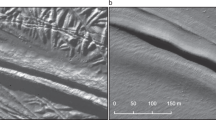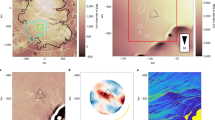Abstract
Penitentes are snow and ice features formed by erosion that, on Earth, are characterized by bowl-shaped depressions several tens of centimetres across, whose edges grade into spires up to several metres tall1,2,3. Penitentes have been suggested as an explanation for anomalous radar data on Europa4, but until now no penitentes have been identified conclusively on planetary bodies other than Earth. Regular ridges with spacings of 3,000 to 5,000 metres and depths of about 500 metres with morphologies that resemble penitentes have been observed by the New Horizons spacecraft5,6,7,8 in the Tartarus Dorsa region of Pluto (220°–250° E, 0°–20° N). Here we report simulations, based upon a recent model3 representing conditions on Pluto7,9, in which deepening penitentes reproduce both the tri-modal (north–south, east–west and northeast–southwest) orientation and the spacing of the ridges of this bladed terrain. At present, these penitentes deepen by approximately one centimetre per orbital cycle and grow only during periods of relatively high atmospheric pressure, suggesting a formation timescale of several tens of millions of years, consistent with crater ages. This timescale implies that the penitentes formed from initial topographic variations of no more than a few tens of metres, consistent with Pluto’s youngest terrains.
This is a preview of subscription content, access via your institution
Access options
Access Nature and 54 other Nature Portfolio journals
Get Nature+, our best-value online-access subscription
$29.99 / 30 days
cancel any time
Subscribe to this journal
Receive 51 print issues and online access
$199.00 per year
only $3.90 per issue
Buy this article
- Purchase on Springer Link
- Instant access to full article PDF
Prices may be subject to local taxes which are calculated during checkout



Similar content being viewed by others
References
Nichols, R. L. Nieves penitentes near Boston, MA. Science 89, 557–558 (1939)
Lliboutry, L. The origin of penitentes. J. Glaciol. 2, 331–338 (1954)
Claudin, P., Jarry, H., Vignoles, G., Plapp, M. & Andreotti, B. Physical processes causing the formation of penitentes. Phys. Rev. E 92, 033015 (2015)
Hobley, D. E. J. How rough is the surface of Europa at lander scale? Lunar Planet. Sci. Conf. XLIV, abstr. 2432 (2013)
Moore, J. M. et al. The geology of Pluto and Charon through the eyes of New Horizons. Science 351, 1284–1293 (2016)
Stern, S. A. et al. The Pluto system: initial results from its exploration by New Horizons. Science 350, aad1815 (2015)
Gladstone, G. R. et al. The atmosphere of Pluto as observed by New Horizons. Science 351, aad8866 (2016)
Moore, J. M. et al. Sublimation as a land-form shaping process on Pluto. Icarus http://dx.doi.org/10.1016/j.icarus.2016.08.025 (in the press)
Toigo, A. D. et al. General circulation models of the dynamics of Pluto’s volatile transport on the eve of the New Horizons encounter. Icarus 254, 306–323 (2015)
Cathles, L. M., Abbot, D. S. & MacAyeal, D. R. Intra-surface radiative transfer limits the geographic extent of snow penitents on horizontal snowfields. J. Glaciol. 60, 147–154 (2014)
Zalucha, A. M. & Gulbis, A. A. S. Comparison of a simple 2-D Pluto general circulation model with stellar occultation light curves and implications for atmospheric circulation. J. Geophys. Res. 117, E05002 (2012)
Toigo, A. D., Gierasch, P. J., Sicardy, B. & Lellouch, E. Thermal tides on Pluto. Icarus 208, 402–411 (2010)
Brown, G. N. Jr & Ziegler, W. T. in Advances in Cryogenic Engineering Vol. 25 (eds Timmerhaus, K. & Snyder, H. A. ) 662–670 (Plenum, 1980)
Young, L. A., Elliot, J. L., Tokunaga, A., DeBergh, C. & Owen, T. Detection of gaseous methane on Pluto. Icarus 127, 258–262 (1997)
Hirschfelder, J. O., Curtiss, C. F. & Bird, R. B. Molecular Theory of Gasses and Liquids (Wiley, 1954)
Sussman, G. J. & Wisdom, J. Numerical evidence that the motion of Pluto is chaotic. Science 241, 433–437 (1988)
Applegate, J. H., Douglas, M. R., Gürsel, Y., Sussmann, G. J. & Wisdom, J. The outer solar system for 200 million years. Astron. J. 92, 176–194 (1986)
Earle, A. M. & Binzel, R. P. Pluto’s insolation history: latitudinal variations and effects on atmospheric pressure. Icarus 250, 405–412 (2015)
Trowbridge, A. J., Melosh, H. J., Steckloff, J. K. & Freed, A. M. Vigorous convection as the explanation for Pluto’s polygonal terrain. Nature 534, 79–81 (2016)
McKinnon, W. B. et al. Convection in a volatile nitrogen ice-rich layer drives Pluto’s geological vigor. Nature 534, 82–85 (2016)
Bergeron, V., Berger, C. & Betterton, M. D. Controlled irradiative formation of penitentes. Phys. Rev. Lett. 96, 098502 (2006)
Mullins, W. W. & Sekerka, R. F. Stability of a planar interface during solidification of a dilute binary alloy. J. Appl. Phys. 35, 444 (1964)
Allison, M. & McEwen, M. A post-pathfinder evaluation of aerocentric solar coordinates with improved timing recipes for Mars seasonal diurnal climate studies. Planet. Space Sci. 48, 215–235 (2000)
Stansberry, J. A. et al. A model for the overabundance of methane in the atmospheres of Pluto and Triton. Planet. Space Sci. 44, 1051–1063 (1996)
Lupo, M. J. & Lewis, J. S. Mass-radius relationships and constraints on the composition of Pluto. Icarus 42, 29–34 (1980)
Brown, R. H., Johnson, T. V., Kirk, R. L. & Soderblom, L. A. Energy sources for Triton’s geyser-like plumes. Science 250, 431–435 (1990)
Melosh, H. J. Planetary Surface Processes Ch. 9 (Cambridge Univ. Press, 2011)
Acknowledgements
J.E.M. was supported in this work by a Discovery Grant (436252-2013) from the Natural Sciences and Engineering Research Council of Canada (NSERC) and C.L.S. was supported by a fellowship under the Integrating Atmospheric Chemistry and Physics from the Earth to Space (IACPES) Collaborative Research and Training Experience (CREATE) programme of NSERC. We thank the New Horizons team for their efforts to plan, develop and operate a mission to explore Pluto. The successful fly-by of 2015 provided publicly available data and peer-reviewed analysis of the surface and atmosphere that enabled the research presented in this paper.
Author information
Authors and Affiliations
Contributions
This research was led by J.E.M., who adapted the penitente model3 to Pluto. C.L.S. led the geometric modelling efforts. A.D.T. and S.D.G. provided insights into the Plutonian atmosphere as well as output data from the PlutoWRF numerical atmospheric and surface energy balance models.
Corresponding author
Ethics declarations
Competing interests
The authors declare no competing financial interests.
Additional information
Reviewer Information Nature thanks D. Abbott and the other anonymous reviewer(s) for their contribution to the peer review of this work.
Extended data figures and tables
Extended Data Figure 1 Diagram showing the penitente geometry.
Initially a parabolic depression in a flat, horizontal surface, model penitentes were generated by rotating by the angle ω, with the positive sense indicated. The light grey region indicates the area in shadow under this orientation and projected solar zenith angle θ, shown in the negative sense.
Extended Data Figure 2 A sample run of the penitente geometry for LS = 230°, showing the distribution of received energy.
This orientation of penitentes at this time of year displays a concentration of energy near the bottom, arising from orientation and self-illumination.
Rights and permissions
About this article
Cite this article
Moores, J., Smith, C., Toigo, A. et al. Penitentes as the origin of the bladed terrain of Tartarus Dorsa on Pluto. Nature 541, 188–190 (2017). https://doi.org/10.1038/nature20779
Received:
Accepted:
Published:
Issue Date:
DOI: https://doi.org/10.1038/nature20779
This article is cited by
-
Large-scale cryovolcanic resurfacing on Pluto
Nature Communications (2022)
-
Penitente formation is unlikely on Europa
Nature Geoscience (2020)
-
Equatorial mountains on Pluto are covered by methane frosts resulting from a unique atmospheric process
Nature Communications (2020)
-
Recent Advancements and Motivations of Simulated Pluto Experiments
Space Science Reviews (2018)
-
Washboard and fluted terrains on Pluto as evidence for ancient glaciation
Nature Astronomy (2018)
Comments
By submitting a comment you agree to abide by our Terms and Community Guidelines. If you find something abusive or that does not comply with our terms or guidelines please flag it as inappropriate.



